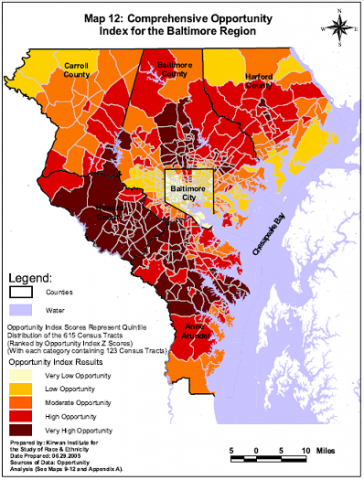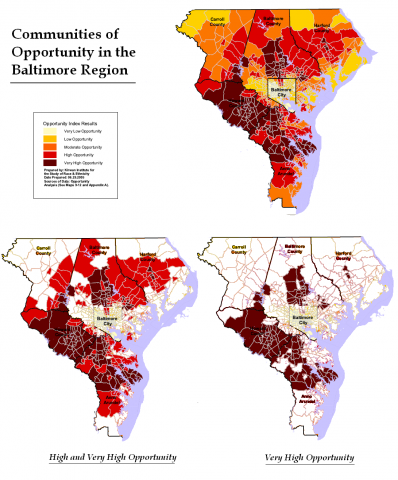This series has embraced data visualization bigtime. In our Baltimore Neighborhood Indicator Alliance data maps, you can see the dividing lines you think you see walking and driving around our region. Racial diversity, unemployment, household income, foreclosures, where jobs are located—there are many perspectives on regional inequality to see by the numbers.
 There’s one really ambitious map we keep going back to: the “communities of opportunity” map created in 2006 by law professor john a. powell. He did it to help the federal government settle a suit over where former residents of high-rise public housing should be moved. The map color-codes the Baltimore region by communities of very low, low, moderate, high, and very high opportunity. You can see it to the right.
There’s one really ambitious map we keep going back to: the “communities of opportunity” map created in 2006 by law professor john a. powell. He did it to help the federal government settle a suit over where former residents of high-rise public housing should be moved. The map color-codes the Baltimore region by communities of very low, low, moderate, high, and very high opportunity. You can see it to the right.
We thought it would be interesting if you coded the map to show just communities of high opportunity. You can see that below. We adapted powell’s map into two maps: communities of “high” or “very high” opportunity, and then just “very high.”
This map is about seven years old now, using some data over a decade old. What do you think would be different about this map if it were updated today? Tell us what you think.

If you’re interested in how powell defines “opportunity” in this map, you can see his report here. (We also have his list of indicators below.) You can also hear him discuss communities of opportunity with Sheilah in our “Lines Between Us” episode about public housing.
john a. powell says his indicators approximate economic opportunity, educational opportunity, and neighborhood health. Appendix A in his report lists them specifically as such:
- “Proximity to Recent Job Growth 1998-2002”
- “Proximity to Potential Entry Level and Low-Skill Jobs 2002”
- “Ratio of Entry Level and Low Skill Employment Opportunities per 1,000 Residents”
- “Proximity (within a ½ mile) of Public Transit Lines”
- “Median Commute to Work Time”
- “Proportion of Students Eligible for Free and Reduced Lunch”
- “Proportion of Classes Not Taught by Highly Qualified Teachers”
- “Proportion of Elementary Students Proficient in Reading”
- “Proportion of Elementary Students Proficient in Math”
- “Rate of Population Change 1990 to 2000”
- “Neighborhood Poverty Rates in 2000”
- “Median Owner Occupied Home Values in 2000”
- “Property Vacancy Rates”
- “Estimated Crime Index 2000”